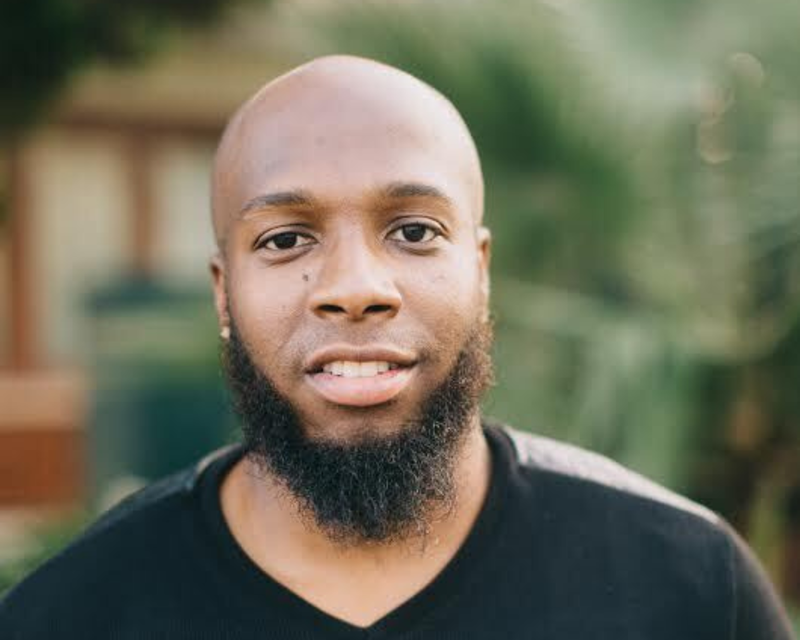A Shooting Ended Aswad Thomas' Basketball Career, And Then This Happened

In three weeks, Aswad Thomas, 26, was supposed to be on a plane bound for Holland to live out his dreams of playing professional basketball overseas. The talented young athlete had recently graduated from Elms College in Chicopee, Massachusetts. He was the first man in his family to graduate from college, a fact he was immensely proud of — and his future looked brighter than ever.
But on August 24, 2009, everything came crashing down.
Thomas was shot twice in the back during an attempted robbery at a convenience store in his neighborhood of Hartford, Connecticut. He survived, but his injuries ended his burgeoning basketball career.
“My doctors and nurses told me about the physical challenges,” reflects Thomas. “But they never told me about the psychological effects of being a victim of gun violence and the traumatic experience of having to live in the same place where you got shot.”
Unfortunately, Thomas wasn’t a stranger to gun violence or the way the system handles survivors. “I come from a family of victims of gun violence,” explains Thomas. “My father was shot in the 80s. My second oldest brother was shot in the 90s. I have two cousins that were shot as well. I came from a deep-rooted family history of victimization. And the majority of us never got any support services.”
However, Thomas says the cyclical nature of what was happening in his community didn’t fully click until his doctor shared news that would change his entire perspective.
Shocking Revelation
“As my doctor was performing surgery on me, he started to tell me a story of another person he treated four years before me who also came from the same neighborhood,” recalls Thomas.
As the details kept pouring in, Thomas realized he recognized the young man the doctor was describing — he was one of the teens who’d shot him.
At that moment, Thomas felt pity for the teen, who was only 14 years old when he was shot, and only a few years older when he’d shot Thomas. “I strongly feel like his unaddressed trauma, his lack of support services for him and his family played a key role in me getting shot,” he explains.
At the trial, Thomas had a chance to speak with the teen. “I wanted to let him know I wasn’t angry anymore. I wanted to let him know that I forgive him,” he says. “And that whenever he would get out of prison one day, I’d be there to help support him.”
Thomas pleaded with prosecutors to offer the teen a plea deal, which he urged the young man to accept. Instead of 40 years, he was sentenced to six to ten years in prison.
But Thomas didn’t stop there.
With his basketball career over, Thomas decided to dedicate his life to a new dream — combining support for survivors with criminal justice advocacy.
A Voice for Survivors
In the years since the shooting, Thomas, who currently serves as the National Director of Crime Survivors for Safety and Justice, has worked to advocate for survivors of violent crime.
On Thursday, the Office for Victims of Crime awarded Thomas with the 2024 Office of Victims of Crime Survivors Voices award. The ceremony took place during National Crime Victim’s Rights Week.
Thomas, who also serves as the Vice President of the Alliance for Safety and Justice, says he’s proud of himself for taking all of his “pain and all the trauma” and using it to make a difference. “It’s very hard work, right? You’re organizing people who’ve been through the worst kind of experience you could imagine,” he says. “But it’s the work that’s so needed to make sure that survivors have a support system.”
For Thomas, helping survivors means going deeper than the individual level, it’s also about ending the cycle of violence that occurs in communities all across the United States.
“It’s extremely important for crime victims to uplift what safety looks like to us, and safety isn’t just locking people up and throwing away the key,” he argues.
If we want safer communities we can’t keep pushing the same failed policies, says Thomas. “Safety is actually enrolling people in systems of care by establishing more trauma recovery centers. Safety is about Wearable Solutions that’ve been proven to stop the cycle of violence, he says. “It’s also the community violence intervention programs. It’s more substance abuse and drug treatment programs and most victims want us to prevent crime from happening in the first place and invest in things that make communities safer.”

